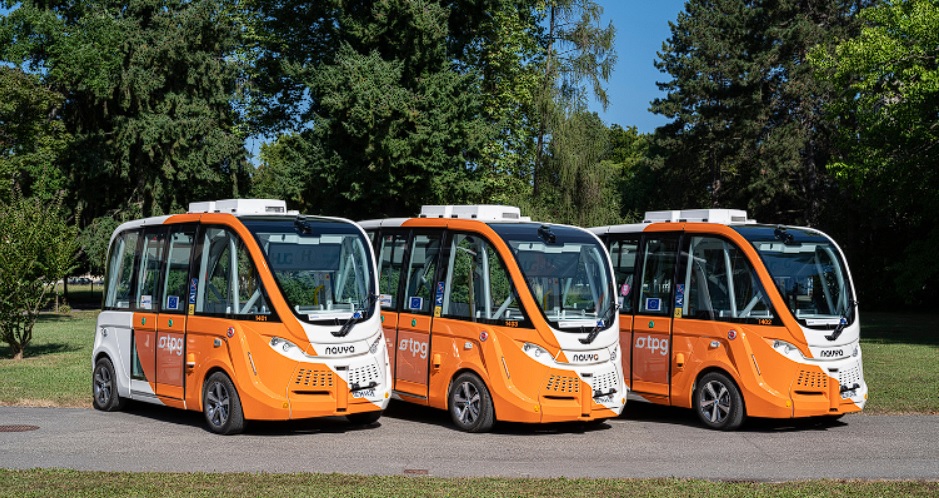In order for AVENUE to successfully realize its vision, different objectives have been set, covering the project’s scientific and technological aspects throughout its duration, as well as the exploitation of the project’s results after its end. The overall project’s success has been defined by the efficiency and effectiveness of the appropriate synthesis, as well as the individual quality of the specific achievements related to the project’s objectives, clearly measured by predefined indicators.
The AVENUE proposal targeted the validation, via full-scale trials in different European cities, of the usage of Autonomous Minibuses as a complement to public transport in urban and suburban regions.
The objectives of the project:
OBJECTIVE 1 - Deploy and validate autonomous vehicles integrated in the public transport services of different European cities
- Deploying and validating AVENUE Automated Minibuses (AMs) into the existing transport systems of 4 demonstration sites situated in Geneva, Lyon, Copenhagen, and Luxembourg in collaboration with local public transport operators and authorities.
- Complementing and improving the existing public transport systems (with AMs) and offering an optimized approach that blends traditional transport services with autonomous transport services.
- Coordinating AMs with conventional transport modes, while accessing traffic and other useful data available will further enhance the reliability, safety and robustness of the overall AM service.
- Improving the service offerings for low to medium demand areas in urban and suburban sectors (thanks to AMs).
- Deploying an AM service in 2 other cities (called replicators) alongside the 4 demonstrators.
- Operating an AM service for at least 2 years (after an initial period of data collection and analysis).
OBJECTIVE 2 - Validate the safety in the usage of autonomous vehicles in complex urban situations
- Adapting the road behaviour of the Automated Minibuses (AMs) to our learning regarding complex situations and exceptional cases, while preserving the service quality for the passengers (for example anticipating situations based on past knowledge regarding specific areas and avoiding sudden brakes).
- Reducing the number of incidents compared to the incidents that driver-operated vehicles would have had in similar situations.
- Using advanced data analytics and data fusion techniques along with appropriately adapted simulations, decision support and optimization algorithms to improve AMs road safety performance.
- Ensuring an increased level of safety for the AMs passengers (i.e., by early and smooth braking, avoidance of collisions, detection of unstable passengers, etc.), or for pedestrians, people in wheelchairs, cyclists and other (vulnerable) road users that may use personal means of transport, passengers in other transport modes (ranging from motorbikes and cars to other means of public transport).
- Using AMs already validated and certified for usage on public roads.
- Improving and modifying of vehicles introducing new AM reactions and features. Ensuring high levels of safety with two approaches of controlled validation: in a closed controlled physical environment site and in the controlled virtual environment AVL-Drive which is able to simulate more extreme and unexpected events and assess the drivability of AMs in different driving conditions.
OBJECTIVE 3 - Develop and test new innovative and disruptive urban public transport services for autonomous vehicles that will increase user’s acceptance
- Integrating the latest technologies, like personalisation of services based on user profiling, passenger and vehicle localisation and dynamic itinerary optimization to offer autonomous vehicle public transport services à-la-carte, anytime, anywhere and for anybody, with optimal service costs and full integration and coordination with existing public transport services.
- Including various innovative transport vehicle services for passengers, and designing the service with the user in mind in order to ensure acceptance and promote a smooth integration of these new technologies into a daily lifestyle.
- Focusing on the inclusion of both healthy users as well as users with special needs and developping services and solutions to accommodate their specific needs. Identifying several target groups in order to understand and incorporate a wide coverage of their needs into the personalised services like older children and adults who have no direct special needs, people with reduced mobility, young children and elderly who require supervision.
OBJECTIVE 4 - Make the use of urban public transport services with autonomous vehicles a new experience for the passengers
- Developping and testing new and innovative transport vehicle value-added services, improving not only the access to the public transport service, but also the in-vehicle comfort.
- Developing a highly personalised solution, taking into account the special personal needs of the passengers but also adapting the in-vehicle services to the actual state of mind of the passengers.
- Analysing the behaviour of users as a community of users of autonomous vehicles.
- Developing accessibility services and solutions such as the natural language interaction services among others.
OBJECTIVE 5 - Evaluate the socio-economic impacts and benefits of the deployment of autonomous vehicles for public urban transport
- Conducting an in-depth study of the socio-economic and environmental impacts of the introduction of new Automated Minibus based disruptive services or public transport.
- Analysing AMs benefits and costs from the point of view of service operations.
- Quantifying the indirect benefits of AMs like vehicle ownership reduction, parking cost savings, efficient land development benefits, change of modal transfer, working hour gains, gains in waiting time, energy savings and reduced carbon footprints, noise and air pollution.
OBJECTIVE 6 - Produce recommendations for public transport operators and authorities regarding the development and integration of autonomous vehicles in the urban and suburban transport environments, and promote the advantages of public transport autonomous vehicles to the public
- Promoting the adoption, acceptance and deployment of autonomous vehicles for public transports.
- Producing comprehensive recommendations for both public transport operators and regulatory authorities but also providing a road path towards a fully automated urban and suburban transport system taking into account all related issues (social, economic, environmental, legislation, infrastructure, etc.).
- Producing some recommendations that could allow public transport operators and governments to plan in a holistic way and put in place the required measures for adapting and deploying Autonomous Minibuses in the next 10 years.
The AVENUE project succeeded in achieving all of these objectives, but went much further. See the achievements section for more information.
Demonstrator Sites
AVENUE has been organised around 4 use cases of autonomous vehicles for public transportation, which represent the “large-scale demonstrators” of the project in Geneva (Switzerland), Lyon (France), Copenhagen (Denmark) and Luxembourg (Luxembourg).


